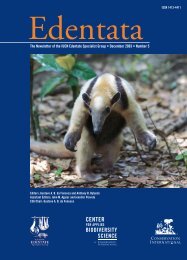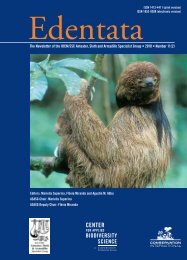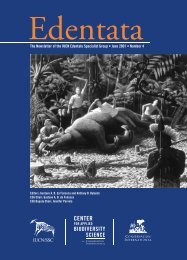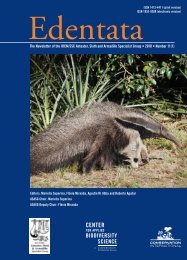Edentata 7 - Anteater, Sloth & Armadillo Specialist Group
Edentata 7 - Anteater, Sloth & Armadillo Specialist Group
Edentata 7 - Anteater, Sloth & Armadillo Specialist Group
- No tags were found...
You also want an ePaper? Increase the reach of your titles
YUMPU automatically turns print PDFs into web optimized ePapers that Google loves.
mating seasons and at seasonal feeding grounds,<br />
giving a false impression of abundance (pers. obs.).<br />
Thus we would caution researchers, conservationists<br />
and decision-makers on the danger of taking these<br />
generalizations too literally, as this may lead to unnoticed<br />
local extinctions. The current situation of sloths<br />
in Colombia may also hold true for other, less-noted<br />
species without organizations dedicated to their survival,<br />
such as the silky anteater (Cyclopes didactylus).<br />
At present there are very few organizations in Colombia,<br />
perhaps a dozen all told, which are working on<br />
the conservation of specific genera.<br />
The Alexander von Humboldt Institute for the Investigation<br />
of Biological Resources (IAvH) is a public<br />
corporation, linked to the Colombian Ministry of<br />
the Environment, which tracks the threat status of<br />
all Colombian fauna. The IAvH lists 16 criteria for<br />
a species at risk of extinction (IAvH, 2005b). Six of<br />
these criteria, we believe, are applicable to Bradypus<br />
and Choloepus in Colombia:<br />
• Species whose populations are known to be<br />
declining;<br />
• Species with low population density;<br />
• Species with a reduced ability to disperse to<br />
new environments;<br />
• Species that are habitat specialists;<br />
• Species that suffer pressure from overexploitation;<br />
and<br />
• Species with close relatives extinct or currently<br />
threatened.<br />
The Colombian Ministry of the Environment does<br />
not list any of these three sloth species as being of<br />
conservation concern (Table 6), probably because<br />
there are no long-term studies to demonstrate<br />
cause for concern. For Colombia and for the international<br />
community, sloths are not focal species<br />
because they are not listed as threatened or potentially<br />
threatened. There are no formal estimates of<br />
sloth densities in Colombia, and this would be the<br />
first step in order to present any estimates of the<br />
total population.<br />
Funds for species protection are always scarce, and<br />
generally go to those species listed as high risk in<br />
IUCN categories, while those that are Least Concern<br />
or Data Deficient are largely ignored. This circle — in<br />
which Data Deficient species receive little attention,<br />
and lack of funding precludes new research — traps<br />
investigators in a frustrating situation, as they are witness<br />
to the worsening situation of many of these species,<br />
but are unable to address it themselves.<br />
At a local level, the limited efforts by police and wildlife<br />
agencies to control the wildlife trade are of no<br />
substantial help. A report from the Procuraduría General<br />
de la Nación, the Colombian Attorney General’s<br />
Office, denounces the lack of legal instruments to<br />
regulate the post-confiscation management of wildlife<br />
in Colombia, as well as insufficient infrastructure and<br />
the lack of reliable statistics on confiscation and illegal<br />
traffic (Rodríguez and Echeverry, 2005). This report<br />
points out that of 251,776 wild animals confiscated<br />
during the period 1996–2004, only 1,639 legal investigations<br />
were initiated. Of these, only 45 resulted in<br />
a fine, while 263 concluded with a lesser sanction.<br />
Recommendations<br />
Predictive models of species distribution, such as the<br />
one we have presented in Fig. 2, are based on easily<br />
accessed environmental data and detailed information<br />
on species localities (Phillips et al., 2006). These<br />
models can be powerful tools that should be used in<br />
species conservation assessments and to facilitate decision-making<br />
processes. Predictive models are not difficult<br />
to develop, and they can be done by researchers<br />
or NGOs with desktop computers running freeware<br />
or shareware. However, modeling also requires broadscale<br />
information, such as vegetation coverage or<br />
ecosystem type, that only government agencies have<br />
the resources to gather. Access to this information is<br />
often limited, and agreements between institutions<br />
are required to take fullest advantage of it.<br />
Threat assessments should take into account the<br />
dangers to local populations, recognizing that many<br />
genetic, biological and ecological factors are still<br />
unknown, especially in the Neotropics. Biodiversity<br />
conservation may be most effective when efforts are<br />
focused on widespread umbrella species rather than<br />
on focal endangered species (Fleishman et al., 2000).<br />
This may be the situation with B. variegatus, which<br />
requires continuous forest canopy to survive; protecting<br />
this sloth would extend the same protection to<br />
many other species that share its rainforest habitat. Its<br />
wide distribution is an added benefit, since its range<br />
is continental in scope. Focal species, on the other<br />
hand, are generally endemic, limited to small regions<br />
and specific habitats. Concentrating efforts on the<br />
protection of focal species may create limitations on<br />
the overall conservation of biodiversity conservation,<br />
and the application of limited funds should be considered<br />
in this context.<br />
Sergio Moreno and Tinka Plese, UNAU Foundation,<br />
Cl. 10E N°25-156, Medellín, Colombia, e-<br />
mail: and .<br />
16<br />
<strong>Edentata</strong> no. 7 • May 2006














